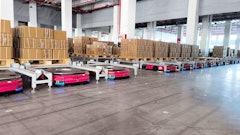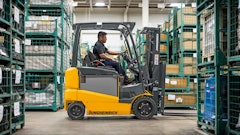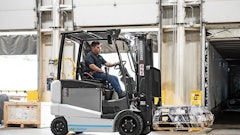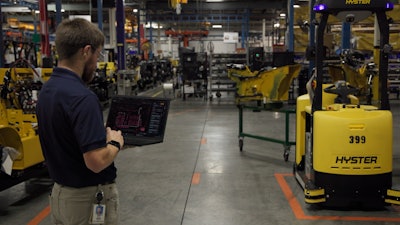
Amid trade policy shifts, global supply chain turbulence and inflation concerns, warehouses and manufacturing facilities face one of the most uncertain economic landscapes since the height of the pandemic. This is slowing down capital investment in warehouse automation as decision-makers grow increasingly wary of large, long-term financial commitments, according to the 2025 Total Addressable Market for Warehouse Automation report from MHI and Interact Analysis. But while CapEx spending stalls, operational pressures haven’t gone anywhere. In fact, they’re intensifying.
Labor shortages continue to be one of the most persistent and costly challenges for manufacturing operations. Facilities are struggling to find and retain skilled workers, and rising labor costs, including overtime, seasonal premiums and turnover are forcing manufacturers to seek scalable alternatives. At the same time, safety and efficiency remain non-negotiable. Automated solutions can address these issues, but for many operations, a lack of experience with automated guided vehicles (AGVs) or the stigma of difficult implementations laces economic uncertainty with technological unknown.
This prompts a new question: How can you adopt automation in a way that doesn’t require a massive upfront investment?
The proof is in the performance
Even companies with available capital are becoming more cautious about spending it. Their hesitation isn’t just financial — it’s practical. Automation demands operational adjustments, changes in employee roles and sometimes even cultural shifts within your facility. Many operations want to see how automation will perform in their own workflows before making a long-term bet on the tech.
When you use an AGV, it’s not just the equipment that changes. Implementing automation means asking workers to adapt from hands-on roles responsible for material moves to oversight roles managing multiple tasks or learning pieces of new processes. As operations work out how to make the most efficient use of automation, foundational elements like the way personnel moves through the facility can change. For example, travel paths that used to be for manually operated lift trucks may become automation-only, possibly causing facility-wide shifts to traffic flow as a result. These are significant adjustments that can require some iteration and don’t always play out as cleanly on the shop floor as they do on paper or in a simulation.
Three CapEx alternatives
As economic conditions force manufacturers to scrutinize every dollar, the flexibility to test automation in real-world conditions without the risk of locking themselves into the long-term commitment of a major capital expenditure (CapEx) becomes increasingly attractive. As new models to pay for automation proliferate, operations have choices that can better align with the desire to test the waters. From Robots-as-a-Service (RaaS) to short-term rentals and leasing, more operating expense (OpEx) models are available that limit upfront cost for automation projects. Here are three alternatives to traditional capital investment when it comes to automation.
1. Robots-as-a-Service
Robots-as-a-service vendors offer the use of their automation based on a licensing agreement rather than purchasing the equipment outright. Payment structures can vary, with some companies using a subscription-based model and others allowing operations to pay as they go. With the latter, you’re charged based on metrics like hours used or tasks completed, in an effort to align cost with performance.
The RaaS model skirts the significant upfront cost of purchasing and maintaining automated lift trucks and provides small- to medium-sized businesses with flexibility and agility. Operations can easily scale up or down their use of AGVs with cost efficiency.
However, RaaS is not without challenges. These solutions require significant customization to meet the needs of specific operations and it’s important to consider the source. RaaS solutions are often provided by smaller robotics startups that may not have size and capability to handle routine maintenance and urgent service needs, nor the staying power to justify a longer-term commitment.
2. Leasing
Leasing is a common, tried-and-true method for equipment acquisition, found everywhere from consumers acquiring passenger vehicles to businesses procuring forklift trucks. It spreads costs out over time and reduces the upfront financial burden compared to outright purchases. However, many lease agreements still require a multi-year commitment. That can be a barrier for companies that want to see the technology operate in their own environment before committing to long-term use. While leasing can ease cash flow concerns and provide a longer-term solution to finance automated units, businesses interested in a true trial experience may want something with a shorter term and greater flexibility.
3. Rental
A rental agreement offers the most frictionless entry point for automation, though operations should exercise caution when evaluating rental terms, particularly as it relates to minimum or maximum lengths. In the right circumstances, a rental can enable manufacturers to deploy even one or two AGVs quickly, often in just a few weeks, and begin evaluating performance right away. Reduced administrative friction and accelerated deployment is another potential advantage. For example, if the cost of a rental agreement is low enough, the decision could possibly be made at the plant level, rather than requiring higher-level corporate approval the way a larger commitment would.
Rentals also create a sandbox environment that allows operations to gather real-world data on everything from equipment usage and uptime to employee adoption and workflow impact. That insight not only supports the case for longer-term investment but also reveals operational tweaks to improve overall efficiency. As manufacturers try to navigate an uncertain environment by making the best, most prudent use of available dollars, the opportunity to “try before they buy” can prove valuable.

![Pros To Know 2026 [color]](https://img.sdcexec.com/mindful/acbm/workspaces/default/uploads/2025/08/prostoknow-2026-color.mduFvhpgMk.png?auto=format%2Ccompress&bg=fff&fill-color=fff&fit=fill&h=100&q=70&w=100)
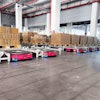





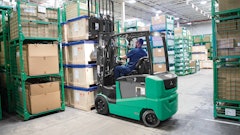
![Pros To Know 2026 [color]](https://img.sdcexec.com/mindful/acbm/workspaces/default/uploads/2025/08/prostoknow-2026-color.mduFvhpgMk.png?ar=16%3A9&auto=format%2Ccompress&bg=fff&fill-color=fff&fit=fill&h=135&q=70&w=240)
